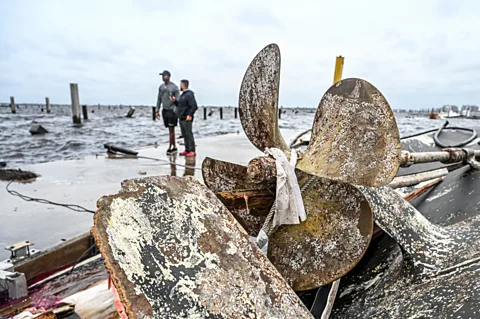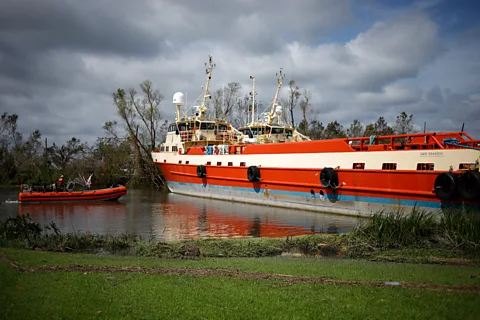Ships in the Gulf of Mexico escaped Hurricane Debby in good time. It's not always so easy
 Getty Images
Getty ImagesLong before a hurricane makes landfall, it has already caused havoc at sea, forcing ships to reroute and burn more fuel. Better data could help keep emissions down as hurricanes grow in strength.
Tropical Storm Debby intensified into a category one hurricane on Sunday 4 August, sparking warnings of high winds and potentially "catastrophic" flooding in the coming hours as it makes landfall in Florida's Big Bend. The hurricane is expected to cause potentially historic rainfall in Florida, Georgia, and South Carolina, according to the National Hurricane Center.
But before hurricanes even make landfall, they can cause significant chaos at sea. Debby's intensification into a hurricane has already prompted port closures and schedule adjustments for ships. The effects have been watched closely by shipping industry experts because the track the storm initially took is traditionally very disruptive to shipping, says Michael O'Brien, chief operating officer at StormGeo, a firm that helps businesses respond to weather events.
When hurricanes race across the Atlantic Ocean, they scatter ships left and right as the vessels reroute to avoid the worst of the storms. The ports those ships are heading to may shut down. Taking alternate routes, these ships burn more fuel. The greenhouse gases streaming from their funnels swell in volume.
Thankfully, in Debby's case, the storm actually missed some of the key shipping routes and oil installations in the Gulf of Mexico. A much more serious effect was felt in June, though, with the arrival of Hurricane Beryl. "It had a massive impact," recalls O'Brien. Among the ships forced off course was the Icon of the Seas – the world's largest cruise ship. O'Brien's company sent a flurry of instructions to captains on how to navigate around Beryl as efficiently as possible. Keeping fuel consumption low not only saves on emissions, it costs shipping firms less, too.
O'Brien says that, without route optimisation, the risk is a 10-15% increase in emissions for ships taking detours around hurricanes. Another company that works with the shipping industry, ZeroNorth, goes further. It estimates potential emissions increases of more than 50%, or around 20% on average, per ship. Both firms provide information to vessels with the intention of curtailing excess emissions.
It matters because this year's Atlantic hurricane season is forecast to be the most active on record, with perhaps as many as eight to 13 hurricanes. Typhoons in the Pacific Ocean can have a similar effect on ships.
 Getty Images
Getty Images"It's a downward spiral," says Søren Meyer, chief executive officer at ZeroNorth, pointing out that storms are getting worse thanks to human-caused climate change, which itself is partly driven by emissions from ships. These bigger storms are, ironically, forcing shipping industry emissions higher still, and further from their climate targets.
It is hard to know exactly how this year's Atlantic hurricane season, and Pacific typhoon season, will play out. But ZeroNorth estimates that, without interventions, stormy weather could bump up emissions from the shipping industry globally by more than 800,000 tonnes of CO2 equivalent (CO2e) in 2024. That's roughly the equivalent of adding 175,000 fossil fuel-powered cars to the world's roads.
"That level of impact would make sense to me," says Stephen Turnock, professor of maritime fluid dynamics at the University of Southampton in the UK. He points out that the shipping industry as a whole produces around one billion tonnes of CO2e annually.
Turnock says that we will likely see a rising "energy cost" associated with more frequent extreme weather events such as hurricanes – ships will burn more fuel and emit more pollutants. That said, the increase in emissions from ships currently avoiding the Red Sea because of Houthi attacks on vessels there is likely to be much more significant. These vessels are taking gigantic detours of about 3,500 nautical miles (4,000 miles/6,500km) to sail around the horn of Africa instead of through the Suez Canal. Such behaviour causes emissions to rise by as much as 38% per voyage, according to industry analysis. Plus, while the response to hurricanes is usually short-lived, these very large detours have now been going on without interruption for many months.
Still, throwing what may turn out to be the most active Atlantic hurricane season on record into the mix certainly doesn't help.
StormGeo's O'Brien says that he and his colleagues provide email and phone assistance to captains who find themselves at risk of meeting a hurricane at sea. This advice can be tailored to each vessel, he emphasises, since it might prove more fuel efficient to stop and wait for the hurricane to pass rather than proceeding along an alternate route, depending on the schedule of the ship in question and the trajectory of the storm.
He shares an example of one vessel that was heading towards the Panama Canal as Hurricane Beryl approached. On StormGeo's advice, the ship waited for Beryl to pass to the south and west. His calculations suggested this saved an estimated 10 tonnes of fuel versus sailing quickly to get ahead of the storm.
As well as being costly in terms of fuel and emissions, racing in front of an extremely powerful storm can be risky. What if the ship's engine breaks down on the way?
"All of a sudden, you're left in the path of the hurricane," says O'Brien.
StormGeo recommends maintaining a minimum of 50 nautical miles between the hurricane and the ship in question at all times. O'Brien notes that his firm's guidance on possible detours can vary depending on the type of vessel. A slow bulk carrier with a lot of cargo on deck will be especially vulnerable to rolling seas so it must avoid rough conditions. Whereas a container ship that can sail more quickly might have greater "wiggle room" in terms of its tactics, says O'Brien.
 Getty Images
Getty ImagesOverall, route optimisation could mean a hurricane-related emissions increase of just 5% or so, instead of 10% or more, he estimates. It can help to keep the crew safe, too.
Meyer says that ZeroNorth helped around 50 vessels change their routes in response to Hurricane Beryl. If even better forecasts become available, which could accurately predict storm activity several days ahead, that would help ships sail more efficiently across oceans, he adds. Outside of hurricanes and typhoons, ZeroNorth tries to help ships avoid strong currents and windy weather in general – since this makes vessels' engines work harder and, consequently, burn more fuel.
Hurricanes affect different kinds of ship in different ways, says Emily Stausbøll at Xeneta, an ocean and air freight analytics service. Container ships might find it easier to reroute and offload their cargo – conveniently packed in containers that can be moved by road or rail – at alternative ports. Oil tankers, conversely, are often required at a specific port so captains might feel a greater incentive to sail as fast as possible to their destination once it becomes safe to do so.
"Oil is kind of critical, you can't sit and wait for three days," she says.
More like this:
She notes another effect of extreme weather on transport emissions, away from the sea itself. In severe drought, rivers and inland waterways can dry up, meaning that barges cannot ferry cargo along them. Alternatives including air and road freight can be significantly worse in terms of emissions.
Meyer argues that the shipping industry should make more use of route optimisation to reduce emissions where possible. According to a 2000 study from the International Maritime Organization, route optimisation could shave 2-4% from shipping industry emissions, on average. Meyer says that much bigger savings than this are possible in response to hurricanes.
The University of Southampton's Turnock agrees that it is worth doing. "It's one of an armoury of tools that are out there for using less energy on ships in the future."
Hurricane Debby might not impact shipping as significantly as Beryl did but, on land in south-eastern states, it could be a different story.
"A strong storm surge in Florida and enormous amounts of rain will impact hundreds of thousands if not millions of people," says O'Brien.
--
For essential climate news and hopeful developments to your inbox, sign up to the Future Earth newsletter, while The Essential List delivers a handpicked selection of features and insights twice a week.
